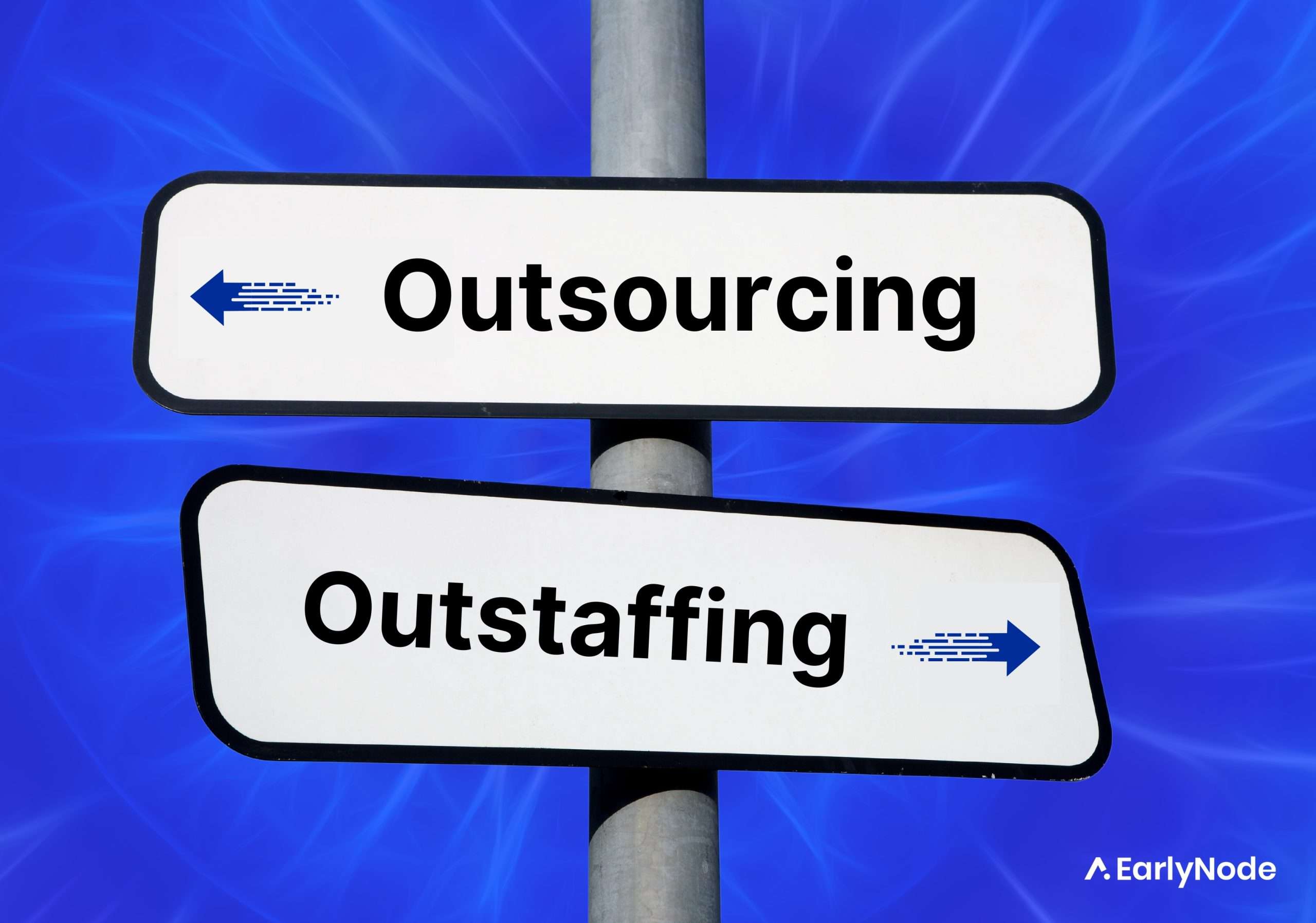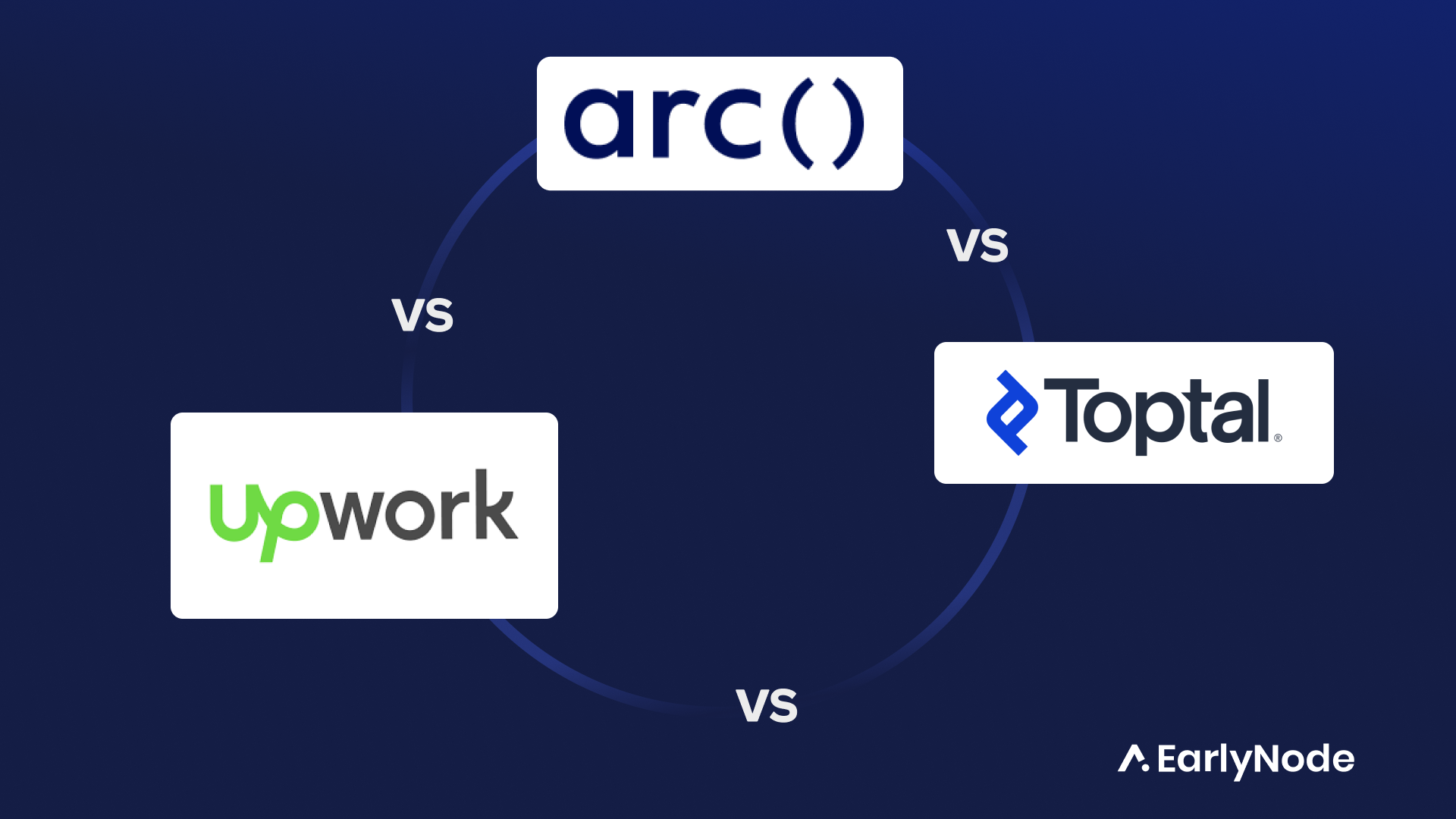Outsourcing vs. Outstaffing for Software Development

TL;DR
- Outsourcing involves hiring a third-party agency to handle a specific task or project. Outstaffing involves hiring remote devs who work exclusively for your company.
- Outsourcing advantages include cost savings, access to a pool of talent, and flexibility for short-term projects. The cons include communication barriers, time zone differences, and a need for more control.
- The pros of outstaffing include control over the development process, access to skilled professionals, and cost savings. The cons include management overheads, a long-term commitment, and dependency on remote teams.
- Choosing between outsourcing and outstaffing depends on a company’s needs and goals. Outsourcing might be the better option if you need a quick and cost-effective solution for short-term projects. But, if you want complete control over the development process, outstaffing might be the way to go.
Outstaffing vs. Outsourcing: Which is the Right Model for Your Software Development Needs?
Software development is a tough nut to crack, needing all sorts of special skills. Now, if you’re a SaaS company trying to get this stuff done, you’ve got two choices: outsourcing or outstaffing. And before you jump in and pick one, you have to get what each means.
We’ll look at the benefits and cons of outsourcing and outstaffing when it comes to software development. We’ll help you decide which one will tick all your boxes. You’ll have a solid idea of what would work best for your software product at the end of this article.
What is Outsourcing?
When we’re talking about software dev, outsourcing is when you bring in another company to build and manage your product.
The company you outsource to is responsible for your product, and they bring everything to the table, like developers, project managers, and folks who make sure the quality is top-notch.
What is Outstaffing?
Outstaffing is a strategic tool for businesses that want remote devs to work just for them. It’s different from outsourcing because these tech whizzes work from anywhere but still take direction from you. The cool part? Your business gets to use all its skills while keeping a firm hand on the product’s progress.
Outsourcing and Outstaffing: What is the difference?
Outsourcing and outstaffing are two popular methods of hiring devs to build your SaaS, each with advantages and disadvantages. Let’s dig into the differences between these two models.
Pros of Outsourcing for Software Development
Cost savings
As a SaaS company, saving some bucks without obviously sacrificing quality is a key goal; that is where outsourcing comes in. Outsourcing is a cost-effective solution that allows your company to use lower labor costs in countries where the cost of living is lower.
Many companies are getting their SaaS products built in places where it’s cheaper to hire. Think about countries like India, China, or Vietnam. Life’s less expensive there, so software developers cost less per hour than they do in the West.
You Also save on office rent, tech gear, and even your monthly utility bills. The outsourcing company takes care of everything.
Access to a broader pool of talent
Outsourcing gets you to work with people with exceptional skills and experience from all over the globe. That can lead to some great new ideas and super innovative solutions you might not have thought of with just your local team.
Remember to do your homework before jumping into outsourcing. Check out potential partners properly to ensure they have the skills, experience, and resources to deliver top-notch work. Also, you’ve got to make sure you’re crystal clear with communication and expectations so that everyone’s on the same page.
Focus on core business activities.
Delegate tasks that are not within your area of expertise to pros who can handle them. This way, your team can zero in on what they’re best at.
By concentrating on your primary goals and entrusting other responsibilities to external experts, you can reduce expenses and gain a competitive advantage.
Flexibility
Outsourcing is super helpful when you’ve got projects that last only a short time, or the workload keeps changing. With outsourcing, you can pull in more help when things get busy and cut back when things slow down.
Reduced Risk
Outsourcing companies have teams full of experienced pros who’ve been there and done that. They have handled similar projects and know how to avoid rookie mistakes.
Aside from having experienced staff, outsourcing companies also handle project management. They work hard to ensure the project is completed on time, so they’re invested in hitting those deadlines and managing costs.
Cons of Outsourcing for Software Development
Communication barriers
When people from different backgrounds and languages get together to work on a project, things can get messy sometimes. Miscommunication due to language hiccups or cultural mix-ups can throw a wrench in the works, causing delays and slip-ups.
Lack of control
Outsourcing is fine and all, but the big headache here is, when you outsource, you’re giving up control over important things. Like, how well the job’s done and how it’s managed.
Bottom line? It’s all about picking the right partner who gets what you’re about and what you want. That way, you can still call the shots and keep things crystal clear while enjoying the perks of outsourcing.
Pros of Outstaffing for Software Development
Control
With outstaffing, you’re fully in control as the boss. You’re in the mix every day, calling the shots on what meets your needs best. This way, you get to work side-by-side with the developers, giving them the low-down and smoothly bringing them into your own process like they’re part of the family. This would keep the teamwork vibes going strong with your team.
Much Lower Cost
Outstaffing is your golden ticket to saving a ton of cash when you need to build a product. Think about it, no worrying about employee benefits, taxes, and all those pesky overheads.
Access to skilled professionals
One of the fantastic things about outstaffing is that you get to pick and choose skilled devs. This way, you can boost your team’s strong points and fix any weak spots without spending extra cash on hiring new staff.
Cons of Outstaffing for Software Development
Cultural differences
When you’re working with an outstaffing team, remember they might have a different culture than yours. Everything from how they work, how they chat about business, and even their professional habits can be different depending on where they’re from.
For example, something that seems normal in one country might come off as rude or unprofessional in another. The same goes for how formal or casual people are in business talks
It’s super important to set up some clear ways to communicate right from the start. This means getting clear about what you expect from each other, scheduling regular catch-ups, and making sure everyone’s on the same page. By taking a minute to get where each other is coming from culturally, you can build a rock-solid working relationship with your outstaffing devs.
Legal and regulatory issues
Keep in mind that legal matters can become complex. The devs might be dealing with different laws and rules, which could put your company in a pickle.
So, before you jump into outstaffing, do your homework. Ensure the devs are playing by the rules in their country by complying with local data protection and privacy laws.
Long-term commitment
Usually, outstaffing isn’t a short-term thing. We’re talking several months or even longer, which may impact resource allocation, project timelines, and overall business strategy. So you’ve got to take a good, hard look at your company’s plans and see if outstaffing lines up with where you want to go.
Dependency on remote teams
Outstaffing can be a handy way to get your hands on the best talent. The only catch is you’ve got to trust your remote team to do their stuff right. It can be nerve-wracking because now your product’s success is in the hands of people who aren’t just down the hall from you.
Luckily, with all the latest tech and communication tools we have these days, managing a remote team is much easier.
What are some Common Misconceptions about Outstaffing and Outsourcing
Outstaffing and outsourcing are the same thing.
Many people think outsourcing and outstaffing are the same, but they’re not. Outstaffing is adding an extra squad to your team. These guys are pros, and they work just for you, even though they’re not physically in your office. They’ll work with you to ensure everything is done the way you want it..
On the other hand, outsourcing is when you hand over projects to another company, and they take care of it all. It’s like saying, “Hey, can you handle this for me?” and then they deliver the product to you. So, it’s not adding to your team but more like getting someone else to sort something out for you.
Outstaffing and outsourcing are only for cost savings.
Outstaffing and outsourcing are about more than just cutting corners on the money side of things. Saving a few bucks is cool, but there’s so much more to it. First, these models give you access to a world of skills you don’t already have in your team. Outstaffing and outsourcing can get you skilled talents who can take your products from okay to awesome.
Another sweet thing about these models is that they’re adjustable. Your team size and resources can be adjusted based on your product needs.
Outstaffing and outsourcing mean sacrificing quality.
People often think that when you outsource or get an outstaffed team, you’re trading off the quality, but that’s not true. Whether you’re outsourcing or outstaffing, you’ve got to set clear goals, and communicate clearly and regularly to ensure everything runs smoothly.
Outstaffing and outsourcing are only for large companies.
Outstaffing and outsourcing are not just for big companies. For small startups, outstaffing and outsourcing can be the perfect solution for overcoming resource constraints and competing with larger companies. Outsourcing dev needs through an outstaffing agency allows small businesses to tap into a broader pool of talent and expertise without worrying about the costs of hiring full-time employees.
Outstaffing vs. Outsourcing; How to Find the Right Partner
Finding the right outsourcing or outstaffing partner for your software dev needs can be challenging. You need to carefully consider several factors, including the partner’s expertise, track record, communication skills, and cultural fit.
These tips and best practices help you find the right outsourcing or outstaffing partner for your needs.
Define your project requirements.
You first have to define your requirements. This includes identifying the tech stack, project scope, budget, timelines, and other specific needs or requirements. Understanding your product requirements will help you narrow your search for the right partner.
Look for experience and expertise.
Look for partners with a good record of delivering high-quality products.. Check out their portfolio, case studies, and client testimonials to be certain of the experience they have working on similar projects.
Assess their communication skills.
Look for partners with excellent communication skills and are fluent in the language(s) you communicate in. This will help minimize language barriers or miscommunications that could affect the product’s success.
Consider cultural fit.
Find partners who share similar values and work ethics as your company. This will help ensure that the partnership runs smoothly and that there are no conflicts or misunderstandings due to cultural differences.
Evaluate their project management processes.
Find partners with well-defined project management methodologies, clear communication channels, and regular progress updates. This will help guarantee that the project is on track and that any issues or risks are identified and addressed promptly.
Conduct due diligence.
Before finalizing the partnership, conduct due diligence to ensure that the outsourcing or outstaffing partner is reliable and trustworthy. Check their references, review their legal agreements, and be certain that they have adequate security measures to protect your sensitive data.
Outsourcing vs. Outstaffing: Which One should you choose for Your Business?
Deciding between outsourcing and outstaffing comes down to your company’s unique needs and goals. Outsourcing could be the right choice if you want a quick, cost-effective solution for short-term projects.
However, if you have a long-term product that demands complete control over the development process, outstaffing might be the way to go.
Use these factors to decide between outsourcing and outstaffing for your business:
Project scope: Outsourcing may be a better fit for specific products, while outstaffing may be better suited for long-term projects or ongoing development.
Budget: Outsourcing may be a more cost-effective solution for businesses with limited budgets, while outstaffing may be more appropriate for companies with larger budgets.
Expertise: You should consider whether you’ll require specific skills that may not be available in-house.
Control: You should consider how much power you require over the development process. Choose the best software development hiring model for your SaaS business by weighing the pros and cons.
Conclusion
Outsourcing and outstaffing are two different models with pros and cons. The right hiring approach ultimately depends on your SaaS business objectives. We hope this comprehensive guide helps you to clearly know the decision that aligns with your requirements and helps you hire correctly.
If you’re looking to beef up your team with top-notch remote React developers consider ReactSquad. Our expert developers are spread across the European and USA time zones. This means we’re always in sync with your schedule!
You can hit the ground running with a ReactSquad developer embedded in your team, shipping code in less than 7 days. No fine print, no surprise fees. Visit our website here to get started today.




